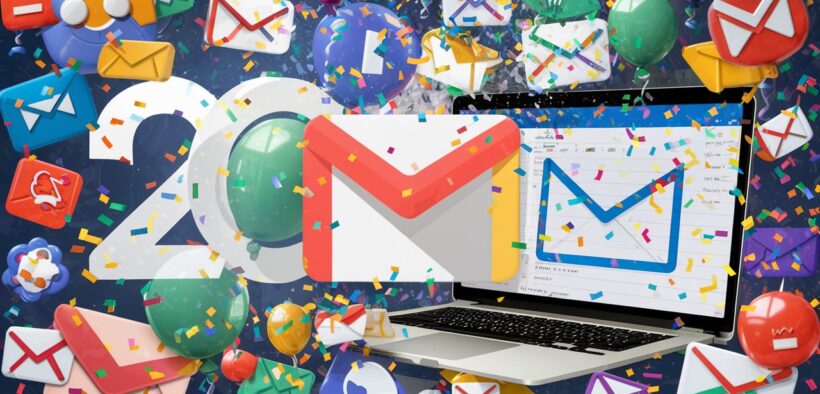Gmail Turns 20: Security Measures Tighten While Email Giant Celebrates Milestone
Share

On April 1st, 2024, Google’s ubiquitous email service, Gmail, celebrates its 20th birthday. This significant milestone coincides with Google’s implementation of new security measures designed to bolster user protection. While Gmail users can rejoice in a more secure inbox, email marketers will need to adapt to the changes or risk seeing their messages disappear into the abyss.
A User Problem, A Google Solution
The year was 2004. In a now-iconic press release, Google, then primarily known for its dominant search engine, announced its foray into the email landscape. The announcement, released on April Fool’s Day, humorously claimed that email, not search, was the internet’s most popular activity. Google’s response? A “search-based webmail service” built to address user email woes. The quote attributed to Google co-founder Sergey Brin in that original press release perfectly encapsulates Google’s user-centric philosophy: “If a Google user has a problem with email, well, so do we.”
Fast forward two decades, and Gmail has undoubtedly conquered the email realm, boasting an estimated 1.2 billion users worldwide. However, the sheer volume of unwanted emails – everything from forgotten subscriptions and marketing blasts to malicious scams – has become a major pain point for users. It’s fitting, then, that Google should address this very issue on Gmail’s 20th birthday.
New Security Measures for Bulk Email Senders
The new security measures target bulk email senders, defined by Google as those dispatching “close to 5,000 messages” to Gmail accounts within a 24-hour window. Email marketers, take heed: failure to comply with stricter authentication protocols will result in bounced emails. Moreover, the bulk sender classification is permanent – exceeding the threshold once ensures your status as a bulk sender remains in effect. Attempts to circumvent the system by sending emails through a network of subdomains will prove futile; Google considers all messages originating from the same primary domain, regardless of subdomains employed.
These new authentication requirements – Domain-based Message Authentication, Reporting & Conformance (DMARC), DomainKeys Identified Mail (DKIM), and Sender Policy Framework (SPF) – are already standard practice for reputable email marketers. As Gmail group product manager Neil Kumaran explains, these measures eliminate loopholes exploited by attackers, fostering a safer email environment for everyone. While not a fool-proof solution against spam and malicious content, these steps significantly enhance inbox security and reduce unwanted emails. However, SubdoMailing, a technique that leverages subdomains for malicious purposes, remains a potential threat to be aware of.
The introduction of these security measures serves as a welcome addition to Gmail’s 20th birthday celebration. While it only applies to personal Gmail accounts, not Google Workspace accounts, any initiative that curbs email scams and spam deserves applause. After all, a cleaner, safer inbox is the perfect present for Gmail users on this momentous occasion.
Gmail: A Secure Evolution from Humble Beginnings to Indispensable Tool
Since its inception, Gmail has prioritized user security, making it a fortress against the ever-present threats of spam, phishing, and malware.
- Two-factor authentication – Over the years, Google has implemented a layered defense. Two-factor authentication (2FA) adds an extra step to logins, thwarting unauthorized access. Emails in transit are shielded with TLS encryption, akin to an armored car for your messages. Finally, Google employs sophisticated machine learning algorithms, acting as vigilant guards that constantly scan and block malicious content.
- Control over the lifespan of your emails – Recent years have seen a focus on user empowerment. Confidential mode grants you control over the lifespan of your emails, allowing them to self-destruct after a set time, preventing unwanted forwarding.
- Integration with AI tools – Gmail’s integration with advanced AI-powered phishing protection acts as a keen-eyed sentry, adept at identifying and eliminating potential threats before they can do harm.
Innovative Features of Gmail for All
Innovation has been another hallmark of Gmail’s success. The platform has consistently introduced features that cater to the evolving needs of its users.
In 2013, the tabbed inbox arrived, bringing order to the chaos. It acts like a filing cabinet, automatically sorting emails into categories like personal messages, social notifications, and promotional offers, making it easier to prioritize and locate important messages.
The “nudge” feature, a recent addition, serves as a gentle but helpful reminder to follow up on important emails, ensuring no critical communication gets lost in the shuffle.
Furthermore, Gmail’s integration with Google’s AI personalizes the experience. By anticipating user needs, it can offer suggestions and complete tasks more efficiently.
As Gmail embarks on its third decade, its commitment to security and innovation remains unwavering. Plans include the introduction of even more AI-powered features alongside enhanced user privacy protections. This unwavering dedication to user needs and experience is what has transformed Gmail from a simple email service into an indispensable tool for millions, solidifying its position as a leader in the ever-changing digital landscape.











Your point of view caught my eye and was very interesting. Thanks. I have a question for you.
Thanks for sharing. I read many of your blog posts, cool, your blog is very good.